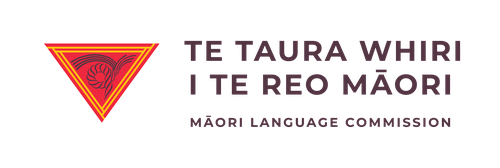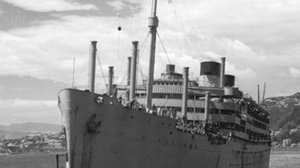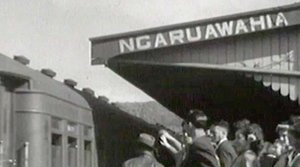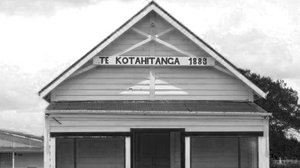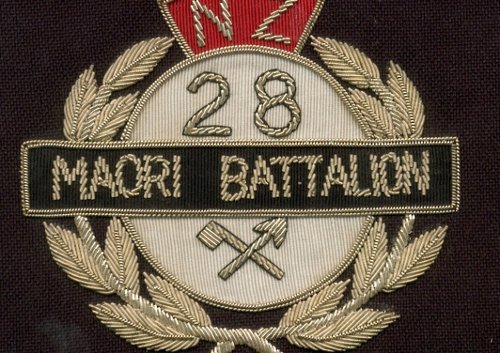
Presenting a rare opportunity to connect with important voices from our past Te Hokinga Mai o Te Rua Tekau mā Waru is the second of four exhibitions from Ngā Taonga Kōrero, the archive of RNZ’s Māori radio programmes.
This exhibition highlights the speeches, supporting waiata and haka delivered to soldiers of the celebrated 28th Māori Battalion as they arrived home in January 1946. Special arrangements, supported by the highest levels of both government and the military, saw about 800 men welcomed home that day.
Video clip used with permission from Archives New Zealand.
January 23, 1946 was a warm Wednesday afternoon when at about 12pm the Dominion Monarch sailed into Wellington Harbour with the remaining members of the 28th Māori Battalion onboard.
Of the almost 3,600 men who volunteered to serve overseas with the 28th Māori Battalion, some 800 returned on the Dominion Monarch to be reunited with whānau, hapū and iwi. 649 of their number had been killed in action or died on active service. At the time the Dominion Monarch sailed into Wellington. approximately 250 men still remained overseas in hospitals or as prisoners of war. Commander of the 2nd NZ Division, Lieutenant-General Bernard Freyberg had said of them:
“… no infantry battalion had a more distinguished record, or saw more fighting, or, alas, had such heavy casualties as the Māori Battalion”.
The initiative to accommodate returning the battalion as a complete unit was supported by senior government and military officials as well as the diplomatic corps of the day. This was so Māori and Pākehā could celebrate together the deeds and sacrifices the battalion had made on the battlefields.
Excitement, anxiety and anticipation were rife onboard as well as on shore when the ship maneuvered its way alongside Pipitea Wharf. The ship was due to have berthed at 7:30am but difficulties navigating the Wellington Harbour Heads forced her delay into port.
The battalion was to have marched from Parliament grounds to Aotea Quay but due to the delays, the men formed up and marched the short distance from Pipitea Wharf. Ex-28th Māori Battalion commanders and Members of Parliament including the acting Prime Minister Walter Nash, were present to receive the soldiers, the Sons of Tūmatauenga.
Wiremu Parker provided the radio commentary while Kīngi Tāhiwi was Master of Ceremonies for the event. Speaking with direct simplicity and eloquence, the kaumātua who spoke at the pōwhiri were mostly born in the 19th century.
Kawa ora from Toroa Ngatauerua
After the pōwhiri in Wellington the men embarked on trains that would carry them home – north to Kaikohe via Hamilton, Ngāruawāhia and Auckland, west to New Plymouth via Whanganui and a third east to Napier and Gisborne. Receptions were held for the battalion at the various points of disembarkment.
The Mobile Recording Unit of the New Zealand Broadcasting Service was present at the Wellington (Aotea Quay), Ngāruawāhia (Tūrangawaewae Marae) and Kaikohe (Te Kotahitanga Marae) receptions. It is these recordings that are held in Ngā Taonga Kōrero and highlighted in this exhibition.
The participants in some of the recordings have been identified, however, there are a few where we have little to no knowledge of who is speaking, or their iwi affiliations. Where information is lacking we are hoping for further information from you, our audience. If there is any information you wish to share please contact us.
The National Film Unit followed the northern train as far as Ngāruawāhia and Weekly Review 232: Māori Battalion Returns features images from the Wellington and Tūrangawaewae pōwhiri. With support from Archives New Zealand Te Rua Mahara o te Kāwanatanga, we have also included the film (above). Sadly we know of no images or voices recorded from the western or eastern journeys home. If you know of any film or audio recordings of these journeys we would be delighted to hear from you.
For more information about the 28 Māori Battalion we encourage you to visit the official 28th Māori Battalion website.
Find out more about the origins of Ngā Taonga Kōrero.
This celebration of te reo Māori is dedicated to those who served in the 28th Māori Battalion. It is generously supported by Te Taura Whiri i te Reo Māori.
